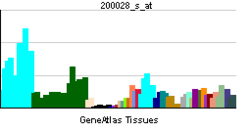NARS (gene)
| Asparaginyl-tRNA synthetase | |||||||||||||
|---|---|---|---|---|---|---|---|---|---|---|---|---|---|
| Identifiers | |||||||||||||
| Symbols | NARS ; ASNRS; NARS1 | ||||||||||||
| External IDs | OMIM: 108410 MGI: 1917473 HomoloGene: 68404 GeneCards: NARS Gene | ||||||||||||
| EC number | 6.1.1.22 | ||||||||||||
| |||||||||||||
| RNA expression pattern | |||||||||||||
 | |||||||||||||
 | |||||||||||||
 | |||||||||||||
| More reference expression data | |||||||||||||
| Orthologs | |||||||||||||
| Species | Human | Mouse | |||||||||||
| Entrez | 4677 | 70223 | |||||||||||
| Ensembl | ENSG00000134440 | ENSMUSG00000024587 | |||||||||||
| UniProt | O43776 | Q8BP47 | |||||||||||
| RefSeq (mRNA) | NM_004539 | NM_001142950 | |||||||||||
| RefSeq (protein) | NP_004530 | NP_001136422 | |||||||||||
| Location (UCSC) |
Chr 18: 57.6 – 57.62 Mb |
Chr 18: 64.5 – 64.52 Mb | |||||||||||
| PubMed search | |||||||||||||
Asparaginyl-tRNA synthetase, cytoplasmic is an enzyme that in humans is encoded by the NARS gene.[1][2][3]
Aminoacyl-tRNA synthetases are a class of enzymes that charge tRNAs with their cognate amino acids. Asparaginyl-tRNA synthetase is localized to the cytoplasm and belongs to the class II family of tRNA synthetases. The N-terminal domain represents the signature sequence for the eukaryotic asparaginyl-tRNA synthetases.[3]
References
- ↑ Cirullo RE, Arredondo-Vega FX, Smith M, Wasmuth JJ (May 1983). "Isolation and characterization of interspecific heat-resistant hybrids between a temperature-sensitive chinese hamster cell asparaginyl-tRNA synthetase mutant and normal human leukocytes: assignment of human asnS gene to chromosome 18". Somatic Cell Genet 9 (2): 215–33. doi:10.1007/BF01543178. PMID 6836455.
- ↑ Beaulande M, Tarbouriech N, Hartlein M (Feb 1998). "Human cytosolic asparaginyl-tRNA synthetase: cDNA sequence, functional expression in Escherichia coli and characterization as human autoantigen". Nucleic Acids Res 26 (2): 521–4. doi:10.1093/nar/26.2.521. PMC 147268. PMID 9421509.
- 1 2 "Entrez Gene: NARS asparaginyl-tRNA synthetase".
Further reading
- Maruyama K, Sugano S (1994). "Oligo-capping: a simple method to replace the cap structure of eukaryotic mRNAs with oligoribonucleotides.". Gene 138 (1-2): 171–4. doi:10.1016/0378-1119(94)90802-8. PMID 8125298.
- Andersson B, Wentland MA, Ricafrente JY, et al. (1996). "A "double adaptor" method for improved shotgun library construction.". Anal. Biochem. 236 (1): 107–13. doi:10.1006/abio.1996.0138. PMID 8619474.
- Yu W, Andersson B, Worley KC, et al. (1997). "Large-scale concatenation cDNA sequencing.". Genome Res. 7 (4): 353–8. doi:10.1101/gr.7.4.353. PMC 139146. PMID 9110174.
- Suzuki Y, Yoshitomo-Nakagawa K, Maruyama K, et al. (1997). "Construction and characterization of a full length-enriched and a 5'-end-enriched cDNA library.". Gene 200 (1-2): 149–56. doi:10.1016/S0378-1119(97)00411-3. PMID 9373149.
- Shiba K, Motegi H, Yoshida M, Noda T (1999). "Human asparaginyl-tRNA synthetase: molecular cloning and the inference of the evolutionary history of Asx-tRNA synthetase family.". Nucleic Acids Res. 26 (22): 5045–51. doi:10.1093/nar/26.22.5045. PMC 147956. PMID 9801298.
- Strausberg RL, Feingold EA, Grouse LH, et al. (2003). "Generation and initial analysis of more than 15,000 full-length human and mouse cDNA sequences.". Proc. Natl. Acad. Sci. U.S.A. 99 (26): 16899–903. doi:10.1073/pnas.242603899. PMC 139241. PMID 12477932.
- Lehner B, Sanderson CM (2004). "A protein interaction framework for human mRNA degradation.". Genome Res. 14 (7): 1315–23. doi:10.1101/gr.2122004. PMC 442147. PMID 15231747.
- Gerhard DS, Wagner L, Feingold EA, et al. (2004). "The status, quality, and expansion of the NIH full-length cDNA project: the Mammalian Gene Collection (MGC).". Genome Res. 14 (10B): 2121–7. doi:10.1101/gr.2596504. PMC 528928. PMID 15489334.
- Rual JF, Venkatesan K, Hao T, et al. (2005). "Towards a proteome-scale map of the human protein-protein interaction network.". Nature 437 (7062): 1173–8. doi:10.1038/nature04209. PMID 16189514.
- Lim J, Hao T, Shaw C, et al. (2006). "A protein-protein interaction network for human inherited ataxias and disorders of Purkinje cell degeneration.". Cell 125 (4): 801–14. doi:10.1016/j.cell.2006.03.032. PMID 16713569.
This article is issued from Wikipedia - version of the Tuesday, September 01, 2015. The text is available under the Creative Commons Attribution/Share Alike but additional terms may apply for the media files.